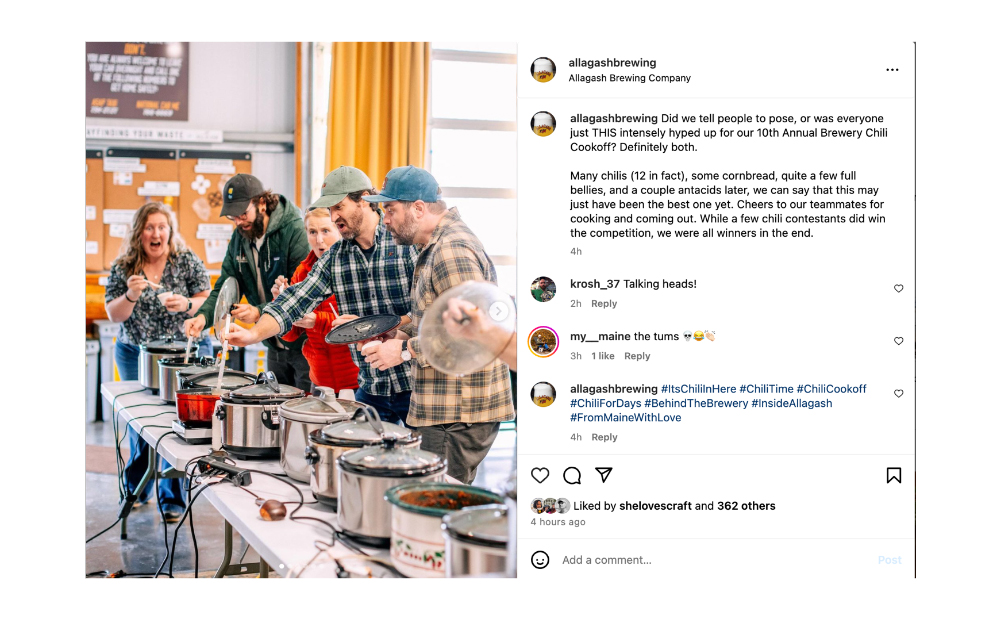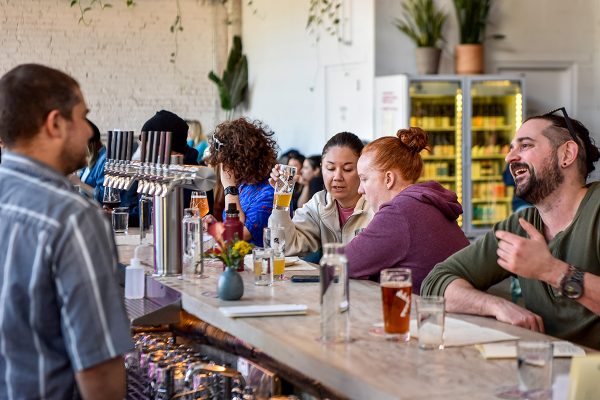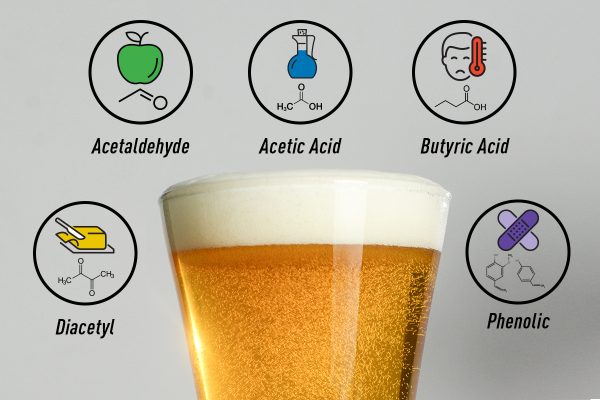Social media can be a cost-effective way for businesses to attract and connect with new customers by adopting some simple best practices. We’ve collected a short list of seven winning strategies from members of the Marketing and Communications Subcommittee of the Brewers Association (BA) Diversity, Equity, and Inclusion Committee.
In Part I of this two-part series, we explore the importance of having engaging visuals, using the event posting capability on major social media platforms, and supporting your local community. In this part, we discuss ways to effectively express your brand voice, target new audiences with psychographic segmentation, make the most out of captions and hashtags, and get your team engaged in social media messaging.
Express Your Brand Voice
As the industry matures, “making great beer” has become less and less of a differentiator. Potential customers and fans need to know more about what makes your brand unique. Simply put, your brand identity is the story of your business. A story that is never told, however, isn’t worth much. If you want your customers to understand your brewery’s values, its history, or what sets you apart, you need to communicate that to them, and there’s no better place to do so than through your social media account.
Reaching new customers increasingly means actively seeking them out and making them feel welcome. It’s not enough for a business to say they don’t exclude anyone. For those who otherwise may not feel like they belong, it’s important to show genuine interest in their business, instead of simply telling them.
This means being unequivocal about your company’s values and ethos, and public about it. It also means consistently showing those principles in practice, with pictures or video always being sure to demonstrate intentional inclusivity. After all, business isn’t given. It’s earned. Show potential new customers and communities that you intend to earn their trust, not simply ask for it.
Using a simple brand voice rubric is one strategy for ensuring that your social media presence consistently delivers the values, ethos, and messaging that will attract and keep new customers.
- Identify three to five elements for your organization’s brand voice. It might be helpful to think of your organization as an individual and the elements of your brand voice as personality traits. Label the column in a simple matrix with the major elements of your brand voice (see sample brand voice rubric below).
- Identify a handful of common categories for your social media content. For example, using people (employees and customers), products (craft beer, food, and merchandise), events and spaces (taproom and weekly events), and community engagement (service projects and job announcements) is a simple way to categorize typical types of social media posts. Label the rows of the matrix with these content categories.
- As you create social media content, use the rubric to ensure that you can clearly categorize the images, videos, and copy in your posts in at least one cell at the intersection of brand voice and content categories. The rubric will not only help ensure that your posts are staying true to your brand voice, but it will also help you to avoid being repetitive in planning future posts.
Sample Brand Voice Rubric
| Trustworthy | Knowledgeable | Irreverent | Imaginative | |
|---|---|---|---|---|
| People | ||||
| Products | ||||
| Events and Spaces | ||||
| Community Relations |
Targeting New Audiences with Psychographics
Audience segmentation is a technique used by marketers to identify subgroups of your target audience that you want to specifically market to. Demographics use identifiers like age, gender, income, education level, and/or geographic location to segment audiences. Many craft brewery marketers use demographics to define their target audiences and then create social media content with those potential customers in mind. But as inclusive marketers, who want to expand our audience scope and reach new potential fans, we should also use psychographic data.
Psychographics is a qualitative methodology of audience segmentation that identifies personal traits and characteristics like values, desires, interests, emotions, goals, lifestyle choices, and purchase preferences. Using demographic and psychographic segmentation allows craft beer marketers to reach new potential customers based on their hobbies or other brands they like or causes they support, instead of pre-judging their preferences based on gender, income, or education level.
Julie Rhodes, owner and operator of Not Your Hobby Marketing Solutions and a Marketing and Communications Subcommittee member, offers, “The reason this methodology works so well for craft beer brands is that alcohol is a conscious choice, so most purchases are made with personal and emotional preferences in mind. If your brand is shown to audiences in a way that resonates with their personal preferences and values, they will be more likely to give your beer a try.”
Social media advertising provides great examples of how to use both demographic and psychographic segmentation with its audience targeting tools. For example, a brewery wants to run an ad for its taproom featuring location and operating hours for potential customers who don’t know about the brand. They can tailor their ad audience by setting an age gate of 21+ and a geographic area within five miles of their taproom to attract more foot traffic. That’s demographic data. But they can go even further to reach more potential customers by adding interests or hobbies to zero in on the audiences that fit their brand personality. Let’s say the brand resonates well with sports fans and the brewery shows a lot of sporting events. Adding psychographic elements like an interest in professional or collegiate sports to your audience segment ensures that your taproom ad is also shown to those who have an interest in sports.
Let Captions Be Your Superpower
Your social media captions can captivate, intrigue, and engage your audience. One of the best ways to reach new audiences with your social media content is to write better captions. While photos and videos will make someone stop scrolling, the caption will keep them engaged.
Here’s how to write a great caption in three simple steps:
- Create a Hook – Your first sentence should grab the reader’s attention. An effective way to do this is to write a caption that’s relatable or celebratory, like announcing some news, posing a question, or expressing an emotion.
- Create the Body – This section should inform, entertain, educate, or inspire the reader, and should also be a relevant follow up to your hook with supporting details
- Provide a Call to Action (CTA) – Your reader can only engage with your post if you tell them what to do with it. CTA examples include statements like, “Click the link in our bio to buy tickets” or “Tag a friend who you want to grab a beer with.”
Using hashtags in your captions is another way to connect with more customers through social media. Just as keywords direct fans to your website through search engines, hashtags allow new audiences to find you on social media. Effective hashtags should be relevant to your brand, but also accessible for multiple types of audiences. This will ensure that you’re reaching the widest scope of potential customers with your content.
To make sure your hashtag is accessible to all, use CamelCase, which is the practice of writing phrases without spaces and capitalizing the first letter of each word. Using CamelCase for social media hashtags allows screen readers to distinguish your hashtags for visually impaired audiences.
If you’re struggling to figure out what hashtags to use for your brand, simply group them into three buckets—broad, narrow, and specific. When using hashtags, make sure you include a broad description of the products you sell or the services you provide, such as #CraftBeer or #Brewery; a narrower set of descriptors, such as #DenverCraftBrewery or #ColoradoCraftBeer; and finally, include a set of specific descriptors (like beer names or interests), such as #PlinyTheElder or #BeerForCamping.
Engage Your Team
Engaging your team on your social media helps develop and personalize your employer brand, which is the way you present your business as a potential employer and the values you share with members of your audience who may be prospective employees. Celebrating members of your staff on social media helps show appreciation for your employees while highlighting your values. Teams are made up of individuals that all have their own networks, interests, and activities. By featuring them on your social networks, you can extend your reach into their audience and beyond. If each person on your team uses their personal social media to share with three more people that they regularly interact with who then share with three more people, you have a much larger network with an increasing variety of people.

When featuring your employees on your social channels, let your team members show their personalities. Businesses are reflective of both the leadership and the team. You will find that your team members are passionate about different topics, whether it’s the environment, diversity, justice, sports, or the arts—encourage them to think of ways of integrating these passions into their jobs and ultimately into your brewery’s social media.
Research and experience show that we all have our own biases and those often extend to your social media managers. The content they create and post are reflections of that fact. Having a social media policy about what is posted, who is reflected, the type of voice to use, and what is not allowed on the business profile, etc. is important so anyone could step in and the same type of content would be put out there—because your social media accounts should reflect the brewery’s look and feel, not just one individual.
By following these tips, you can extend your reach beyond your current audience and connect with other beer-loving people in your area.

Because Your Business is More than the Liquid.
Get news, resources, tools, and more to help your team THRIVE.






